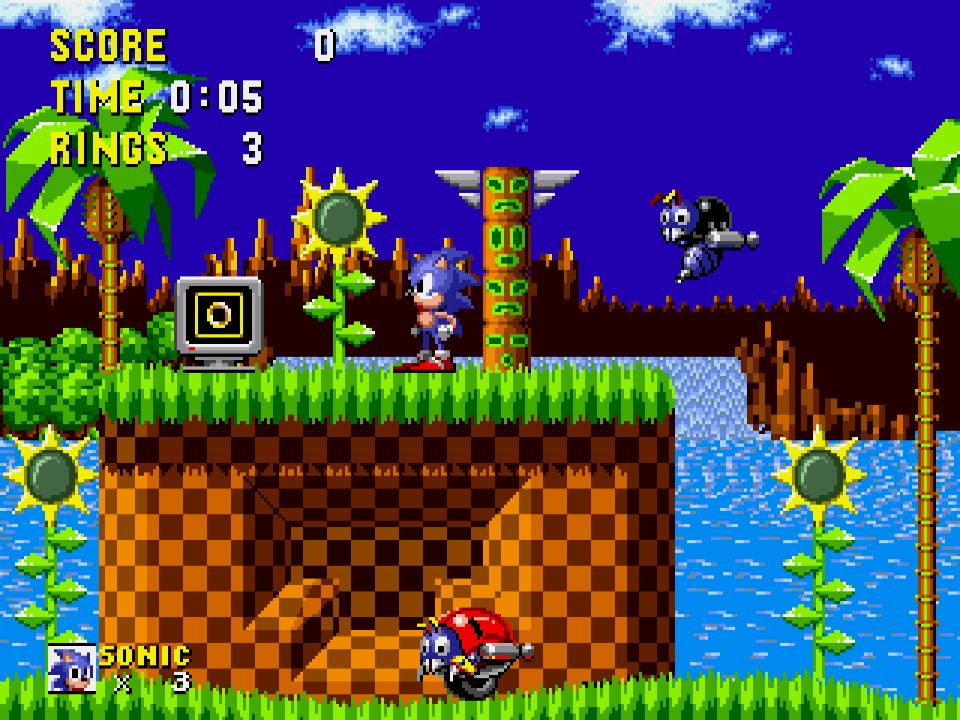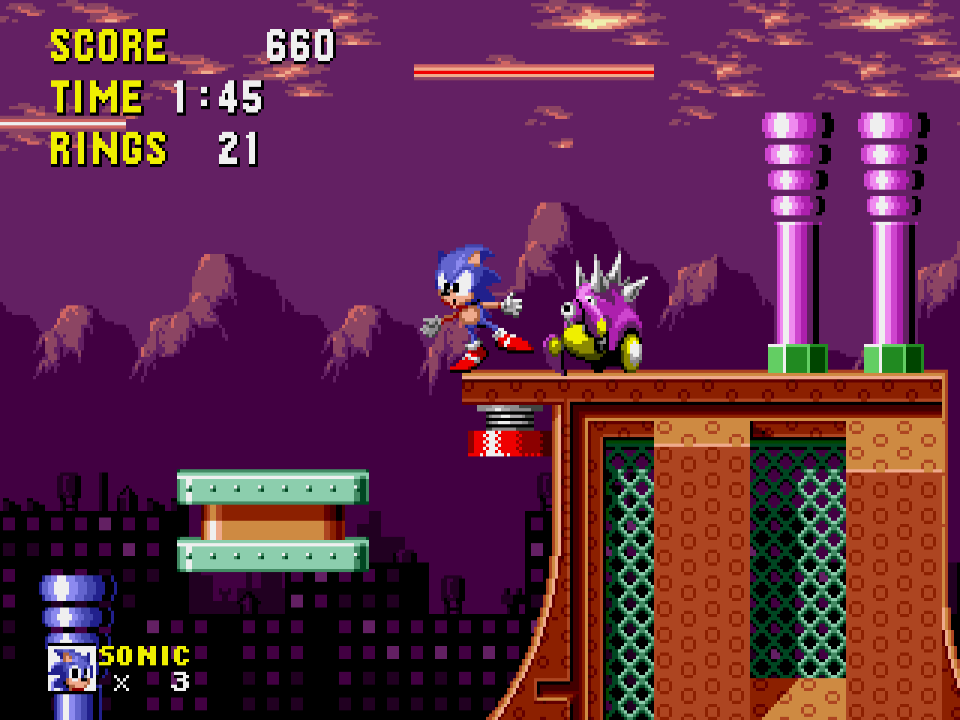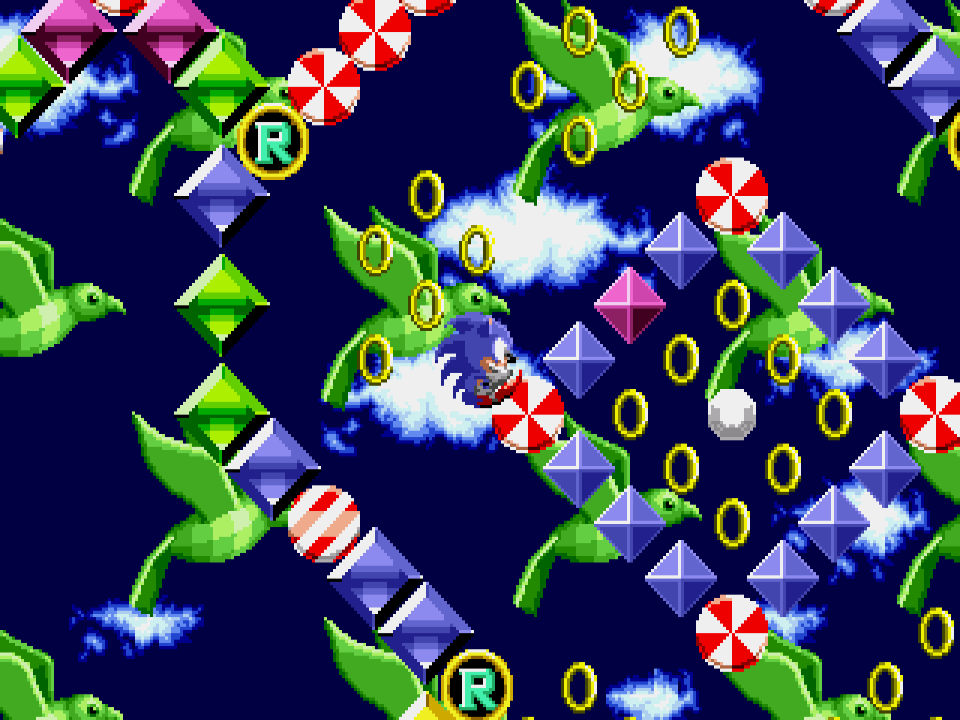Retrogaming Reviews
Latest · Alphabetical · Score · Picks · Random
Consoles
Arcade · Genesis · PS1 · PSP · SNES · TG-16
Sega Genesis / Mega Drive · 2D Platformer · 1991
The Blue Hedgehog
Cast your mind back to the halcyon days of the year 1991: the Cold War had ended, the internet as we know it was taking its first few tentative steps, and the Super Nintendo had just made its way across the seas to North America and beyond. As the Cold War ended, the console wars began, featuring Sega and Nintendo as bitter rivals. With the advent of the Genesis, a console originally intended to rival the venerable NES, Sega needed a new mascot to compete with Nintendo’s mustachioed plumber.
That mascot came in the form of Sonic the Hedgehog, a character who fit perfectly into the zeitgeist of the early 90s. Move aside, Mario! Despite being a cartoon hedgehog, Sonic is cool and edgy! He’s got attitude! He appeals to the cool kids! Nintendo is for babies, Sega has Sonic!
And with it came his flagship title, the eponymous Sonic the Hedgehog. Joining the fray two years after the Genesis’ launch in North America, Sonic promised a cooler, faster platformer than the likes of Super Mario. Speed was the name of the game — with the power of the Genesis’ “blast processing”[1], this blue hedgehog was ready to wow gamers with never-before-seen, lightning-fast platforming. Gotta go fast![2]
At least, that’s what the marketing said.
The Game
Playing as the spiny blue speed freak himself, the gameplay involves navigating through a number of stages — subdivided into themed “zones”. Each zone is divided into three “acts”, or separate levels, and the goal in the first two acts is to simply reach the signpost at the end of the stage. In the third act, you face off against your nemesis, the evil Dr. Robotnik[3], where he employs various diabolical machinery to defeat our chili-dog-devouring hero.
Golden rings are distributed liberally throughout the world, and if Sonic is holding any number of rings, he’ll be able to survive otherwise lethal damage — at the cost of dropping his rings, scattering them everywhere. He can also obtain ther power-ups — such as a shield, a temporary speed-boost, and limited invincibility.
It’s a pretty cut-and-dry standard platformer for the most part. While the marketing emphasizes the speed of the game, and indeed some sections encourage speed — with spring-loaded bumpers, loop-de-loop tracks, and even walls that Sonic can be tunnel through with enough, well… speed. However, given the frequency of hazards — and the ease at which Sonic can run into a lethal spike trap or a mechanical baddie — it feels like the game encourages more of a slow-and-steady approach, contrary to its intention.
Collecting 50 or more rings and jumping into the giant ring at the end of the stage leads to the Special Stage. In this bizarre minigame with dreamlike visuals, Sonic can work his way through one of several rotating mazes, hoping to claim one of the seven Chaos Emeralds needed for the game’s true ending. It’s an entirely optional challenge, but a fun addition to the game.
What Makes It Good?
Despite its apparent ambivalence about whether it wants Sonic to go fast or slow, the controls are on point. Whether he’s running, jumping, or rolling into a spiny blue ball of death, Sonic feels absolutely fantastic to control. Super Mario this ain’t, but I’d honestly say the quality of controls are close to being on par.
Visually, Sonic the Hedgehog really plays to the Genesis’ strengths. Each different zone is an absolute aesthetic treat of vibrant colours and fun animations — from the rolling grassy hills and sapphire-blue waterfalls of the Green Hill Zone to the steel walls and belching flames of the Scrap Brain Zone, each area feels unique and distinct. The environments and enemies are bright, colourful and wonderfully unique. Everything just pops in the way that the Genesis does so well.
Audio-wise, the game also excels — the sound effects are as charming as the visuals. From the bwoop of Sonic’s bounce, to the pling of collecting the golden rings, to the satisfying pop of a defeated robot baddie, it matches the aesthetic perfectly.
The music, composed by Masato Nakamura, is best described as absolutely bangin’. Personal favourites of mine include Green Hill Zone, Scrap Brain Zone, and Robotnik’s boss music. With that said — it’s stellar all the way, and makes excellent use of the Genesis’ Yamaha YM2612 sound chip, providing fun and exciting background music.
It’s fast, it’s fun, it’s exciting and energetic, and it’s a treat for the senses. While not a perfect game — and somewhat outshone by its later sequels — it’s still an absolute joy to play. Without a doubt, I’d recommend Sonic the Hedgehog to gamers of all ages[4].
The Verdict

Footnotes
[1] This was just marketing bullshit at the time, but again, it fit into the zeitgeist.
[2] "Gotta go fast" wasn't even Sonic's thing until the mid-2000s. The more you know.
[3] Also known as Dr. Eggman.
[4] Just don't ask how long it took my sister and I to get through Green Hill Zone when we were kids.
Discussion
If your comment doesn't show up right away, don't worry! Sometimes they can be delayed, but it'll appear soon.











